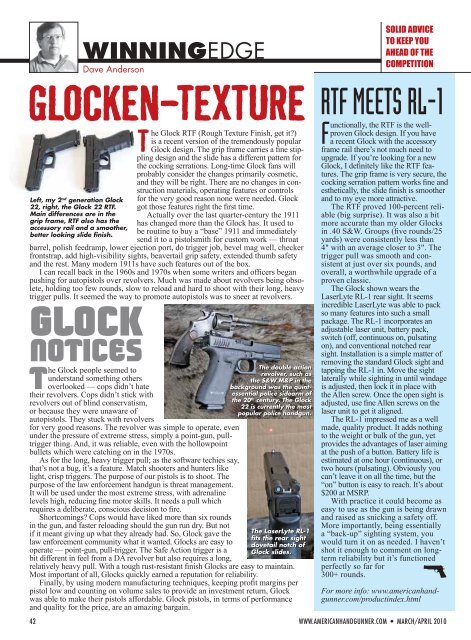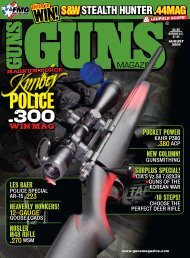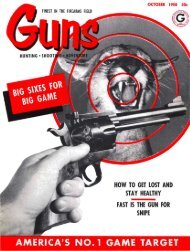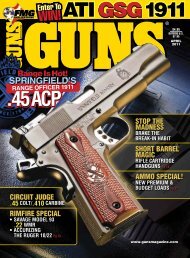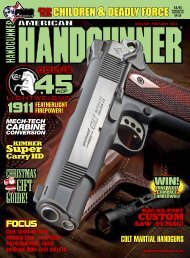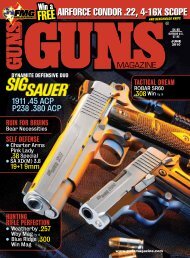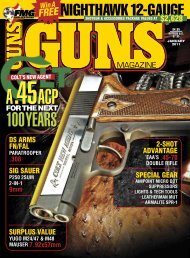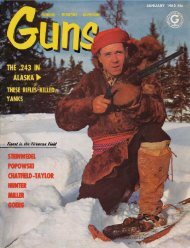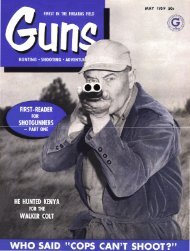22 OF OF OF 22 22 - Jeffersonian
22 OF OF OF 22 22 - Jeffersonian
22 OF OF OF 22 22 - Jeffersonian
- No tags were found...
Create successful ePaper yourself
Turn your PDF publications into a flip-book with our unique Google optimized e-Paper software.
WINNINGEDGEDave AndersonSOLID ADVICETO KEEP YOUAHEAD <strong>OF</strong> THECOMPETITIONGlocken-TextureThe Glock RTF (Rough Texture Finish, get it?)is a recent version of the tremendously popularGlock design. The grip frame carries a fine stipplingdesign and the slide has a different pattern forthe cocking serrations. Long-time Glock fans willprobably consider the changes primarily cosmetic,and they will be right. There are no changes in constructionmaterials, operating features or controlsLeft, my 2 for the very good reason none were needed. Glocknd generation Glock<strong>22</strong>, right, the Glock <strong>22</strong> RTF. got those features right the first time.Main differences are in the Actually over the last quarter-century the 1911grip frame, RTF also has thehas changed more than the Glock has. It used toaccessory rail and a smoother,be routine to buy a “base” 1911 and immediatelybetter looking slide finish.send it to a pistolsmith for custom work — throatbarrel, polish feedramp, lower ejection port, do trigger job, bevel mag well, checkerfrontstrap, add high-visibility sights, beavertail grip safety, extended thumb safetyand the rest. Many modern 1911s have such features out of the box.I can recall back in the 1960s and 1970s when some writers and officers beganpushing for autopistols over revolvers. Much was made about revolvers being obsolete,holding too few rounds, slow to reload and hard to shoot with their long, heavytrigger pulls. It seemed the way to promote autopistols was to sneer at revolvers.GlockNoticesThe Glock people seemed tounderstand something othersoverlooked — cops didn’t hatetheir revolvers. Cops didn’t stick withrevolvers out of blind conservatism,or because they were unaware ofautopistols. They stuck with revolversfor very good reasons. The revolver was simple to operate, evenunder the pressure of extreme stress, simply a point-gun, pulltriggerthing. And, it was reliable, even with the hollowpointbullets which were catching on in the 1970s.As for the long, heavy trigger pull; as the software techies say,that’s not a bug, it’s a feature. Match shooters and hunters likelight, crisp triggers. The purpose of our pistols is to shoot. Thepurpose of the law enforcement handgun is threat management.It will be used under the most extreme stress, with adrenalinelevels high, reducing fine motor skills. It needs a pull whichrequires a deliberate, conscious decision to fire.Shortcomings? Cops would have liked more than six roundsin the gun, and faster reloading should the gun run dry. But notif it meant giving up what they already had. So, Glock gave thelaw enforcement community what it wanted. Glocks are easy tooperate — point-gun, pull-trigger. The Safe Action trigger is abit different in feel from a DA revolver but also requires a long,relatively heavy pull. With a tough rust-resistant finish Glocks are easy to maintain.Most important of all, Glocks quickly earned a reputation for reliability.Finally, by using modern manufacturing techniques, keeping profit margins perpistol low and counting on volume sales to provide an investment return, Glockwas able to make their pistols affordable. Glock pistols, in terms of performanceand quality for the price, are an amazing bargain.The double actionrevolver, such asthe S&W M&P in thebackground was the quintessentialpolice sidearm ofthe 20 th century. The Glock<strong>22</strong> is currently the mostpopular police handgun.The LaserLyte RL-1fits the rear sightdovetail notch ofGlock slides.RTF Meets RL-1Functionally, the RTF is the wellprovenGlock design. If you havea recent Glock with the accessoryframe rail there’s not much need toupgrade. If you’re looking for a newGlock, I definitely like the RTF features.The grip frame is very secure, thecocking serration pattern works fine andesthetically, the slide finish is smootherand to my eye more attractive.The RTF proved 100-percent reliable(big surprise). It was also a bitmore accurate than my older Glocksin .40 S&W. Groups (five rounds/25yards) were consistently less than4" with an average closer to 3". Thetrigger pull was smooth and consistentat just over six pounds, andoverall, a worthwhile upgrade of aproven classic.The Glock shown wears theLaserLyte RL-1 rear sight. It seemsincredible LaserLyte was able to packso many features into such a smallpackage. The RL-1 incorporates anadjustable laser unit, battery pack,switch (off, continuous on, pulsatingon), and conventional notched rearsight. Installation is a simple matter ofremoving the standard Glock sight andtapping the RL-1 in. Move the sightlaterally while sighting in until windageis adjusted, then lock it in place withthe Allen screw. Once the open sight isadjusted, use fine Allen screws on thelaser unit to get it aligned.The RL-1 impressed me as a wellmade, quality product. It adds nothingto the weight or bulk of the gun, yetprovides the advantages of laser aimingat the push of a button. Battery life isestimated at one hour (continuous), ortwo hours (pulsating). Obviously youcan’t leave it on all the time, but the“on” button is easy to reach. It’s about$200 at MSRP.With practice it could become aseasy to use as the gun is being drawnand raised as snicking a safety off.More importantly, being essentiallya “back-up” sighting system, youwould turn it on as needed. I haven’tshot it enough to comment on longtermreliability but it’s functionedperfectly so far for300+ rounds.*For more info: www.americanhandgunner.com/productindex.html42 WWW.AMERICANHANDGUNNER.COM • MARCH/APRIL 2010


